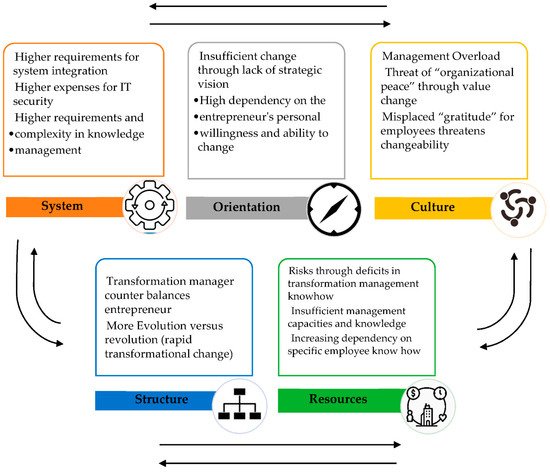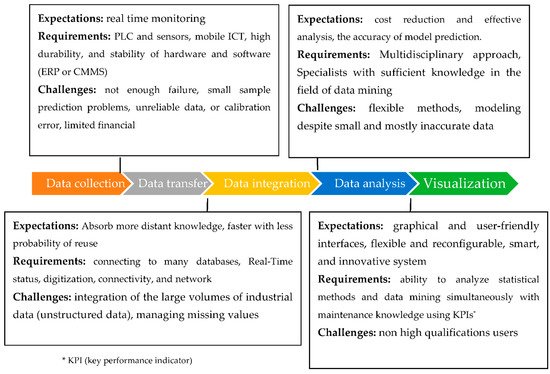Small- and medium-sized enterprises (SMEs) play an important role in the economy of societies. Although environmental factors, such as COVID-19, as well as non-environmental factors, such as equipment failure, make these industries more vulnerable, they can be minimized by better understanding the concerns and threats these industries face. Only a few SMEs have the capacity to implement the innovative manufacturing technologies of Industry 4.0.
- predictive maintenance
- SMEs
- expectations
- requirements
- challenges
1. Introduction
Physical assets play a key role in fulfilling the needs of factories and companies. However, installation is highly automated and technically very complex, and, as a result, maintenance management has had to become more sophisticated to meet higher technical and commercial expectations. A wide variety of people work in very inefficient industrial environments [1] In addition, much research has been conducted on the maintenance of machine repairs over the past several decades, with studies on different phases of maintenance, including run-to-failure or corrective maintenance, preventive or scheduled maintenance, and predictive maintenance. The extant literature [1][2][3][4][5], reports significant results for the performance of different phases of maintenance.
Figure 1 [5] gives an overview of the maintenance types. There are several maintenance strategies that can be identified according to their roles. Companies have to decide what kind of strategy works for them. In the case of run-to-failure (RTF), companies risk the failure of systems because they did not maintain them in advance. Preventive maintenance (PvM) can cause inefficient replacement of parts, often before the end of their service life. Effective and reliable maintenance strategy should improve the conditions of the equipment, reduce unexpected system failures, and minimize maintenance costs while maximizing the working time of system components. Regarding these factors, the predictive maintenance (PdM) strategy stands out amongst the others because it optimizes the utilization of equipment, maximizes operation time of system component, and reduces risks from unexpected failures. PdM is related to the high degree of digitization and implementation of the industry 4.0 concept. Its advantages include maximizing the time of use and operation of equipment, delaying and/or reducing maintenance activities, and reducing material and labor costs [6].

Currently, according to Baglee et al. [7], SMEs generally use preventive or reactive maintenance strategies. As mentioned in their work, preventive refers to scheduling maintenance processes irrespective of the current state of the machine, whereas reactive refers to maintenance activities due to a change of state or anomaly.
Industry 4.0 is mainly offered by larger companies, and small and medium-sized companies are at risk of not being able to exploit this enormous potential. However, micro-, small-, and medium-sized companies provide about 45% of the value added of production and about 59% of employment and can, therefore, be considered the backbone of the European economy. Therefore, Industry 4.0 concepts should not only be conceived of and implemented in larger companies but also, and arguably more importantly, implementation solutions, approaches, concepts, and technology solutions for efficient implementation should be provided for SMEs [8].
2. SME Challenges

| Actors | Interactions between the entities and stakeholders |
| Adopt a philosophy in an integrated organization | |
| Adopt a strategy in an integrated organization | |
| Budget reclassification between units | |
| Information | Acquire the required qualifications |
| Value Proposition | Requires a systematic process for service innovation by digital technology |
| Implement a culture of failure in the organization |
3. Requirement
4. Summary of Studies and RQ Answers

-
Data collection: To obtain relevant data and manage its content. Data can be collected from a variety of sources, including sensors, RFID tags, people, and so on.
-
Data transfer: The collected data need to be transferred without affecting their content. Data are transferred from the source to the data management system.
-
Data integration: Combining data from different sources in a data warehouse using methods that ensure its quality.
-
Data analysis: Data analysis and extract information and knowledge to support decision making by managers.
-
Visualization: By visualizing the information required by the users or decision makers. Visualization can be statistical or reporting.
This entry is adapted from the peer-reviewed paper 10.3390/machines9090191
References
- Pintelon, L.; Parodi-Herz, A. Complex System Maintenance Handbook; Springer: Berlin, Germany, 2008.
- Al-Turki, U.M.; Ayar, T.; Yilbas, B.S.; Sahin, A.Z. Integrated Maintenance Planning in Manufacturing Systems; SpringerBriefs in Applied Sciences and Technology no. 9783319062891; Springer: Berlin, Germany, 2014; pp. i–iv.
- Susto, G.A.; Pampuri, S.; Schirru, A.; Beghi, A. Optimal Tuning of Epitaxy Pyrometers a Predictive Maintenance System for Silicon. In Proceedings of the 2012 SEMI Advanced Semiconductor Manufacturing Conference, Saratoga Springs, NY, USA, 15–17 May 2012; pp. 294–299.
- Susto, G.A.; Beghi, A.; De Luca, C. A Predictive Maintenance System for Epitaxy Processes Based on Filtering and Prediction Techniques. IEEE Trans. Semicond. Manuf. 2012, 25, 638–649.
- Wang, K.-S.; Li, Z.; Braaten, J.; Yu, Q. Interpretation and compensation of backlash error data in machine centers for intelligent predictive maintenance using ANNs. Adv. Manuf. 2015, 3, 97–104.
- Kumar, A.; Chinnam, R.B.; Tseng, F. An HMM and polynomial regression based approach for remaining useful life and health state estimation of cutting tools. Comput. Ind. Eng. 2019, 128, 1008–1014.
- Baglee, D.; Knowles, M. Maintenance strategy development within SMEs: The development of an integrated approach. Control Cybern. 2010, 39, 275–303.
- Matt, D.T.; Modrák, V.; Zsifkovits, H. Industry 4.0 for SMEs: Challenges, Opportunities and Requirements; Springer International Publishing: Cham, Switzerland, 2020.
- Gualtieri, L.; Palomba, I.; Wehrle, E.J.; Vidoni, R. The Opportunities and Challenges of SME Manufacturing Automation: Safety and Ergonomics in Human–Robot Collaboration. In BT—Industry 4.0 for SMEs: Challenges, Opportunities and Requirements; Palgrave Macmillan: London, UK, 2020.
- Jantunen, E.; Emmanouilidis, C.; Arnaiz, A.; Gilabert, E. Economical and technological prospects for e-maintenance. Int. J. Syst. Assur. Eng. Manag. 2010, 1, 201–209.
- Jerrentrup, R. Digital Transformation in SMEs—Lean Management + Industry 4.0; Springer Fachmedien: Wiesbaden, Germany, 2020.
- Majstorović, V.D.; Mitrović, R.M.; Mišković, Ž.Z. Assessing industry 4.0 readiness in manufacturing companies from Serbia. In Lecture Notes in Mechanical Engineering; Springer: Berlin, Germany, 2020; pp. 69–79.
- Li, B.-R.; Wang, Y.; Dai, G.-H.; Wang, K.-S. Framework and case study of cognitive maintenance in Industry 4.0. Front. Inf. Technol. Electron. Eng. 2019, 20, 1493–1504.
- Xiong, S.; Liu, Y.; Fang, J.; Dai, J.; Luo, L.; Jiang, X. Incipient Fault Identification in Power Distribution Systems via Human-Level Concept Learning. IEEE Trans. Smart Grid 2020, 11, 5239–5248.
- Dobrotvorskiy, Y.; Basova, S.; Dobrovolska, L.; Sokol, Y.; Kazantsev, N. Big Challenges of Small Manufacturing Enterprises in Industry 4.0; Springer International Publishing: Cham, Switzerland, 2020; Volume 1.
- Starr, A.; Al-Najjar, B.; Holmberg, K.; Jantunen, E.; Bellew, J.; Albarbar, A. Maintenance today and future trends. In E-Maintenance; Springer: Berlin, Germany, 2010; pp. 5–37.
- Thalmann, S.; Schäper, S. Localizing knowledge in networks of SMEs—Implication of proximities on the IT support. In Knowledge Management in Digital Change; Springer: Berlin, Germany, 2018; pp. 189–206.
- Hern, E.; Rodr, S.; Mart, T.S.; Gonz, A. Machine Learning Predictive Model; Springer: Berlin, Germany, 2015; Volume 1, pp. 501–510.
- Xu, X. Combination Prediction Method of Power Transformers Based on Feature Gas Arrangement Diagram and Grey Model. In Proceedings of the 2018 IEEE Conference on Electrical Insulation and Dielectric Phenomena (CEIDP), Cancun, Mexico, 21–24 October 2018; pp. 406–409.
- Heinis, T.B.; Hilario, J.; Meboldt, M. Empirical study on innovation motivators and inhibitors of Internet of Things applications for industrial manufacturing enterprises. J. Innov. Entrep. 2018, 7, 10.
- Kordon, A.K. Business problems dependent on data. In Applying Data Science; Springer: Berlin, Germany, 2020; pp. 39–67.
- Sezer, E.; Romero, D.; Guedea, F.; MacChi, M.; Emmanouilidis, C. An industry 4.0-enabled low cost pre-dictive maintenance approach for SMEs: A use case applied to a CNC Turning Centre. In Proceedings of the 2018 IEEE International Conference on Engineering, Technology and Innovation (ICE/ITMC), Stuttgart, Germany, 17–20 June 2018; pp. 1–8.
- Campos, J.; Jantunen, E.; Baglee, D.; Gilabert, E.; Fumagalli, L.; Emmanouilidis, C. The use of mobile tech-nologies and their economic benefits in maintenance. In Proceedings of the 10th World Congress on Engineering Asset Management (WCEAM 2015), Tampere, Finland, 28–30 September 2015; Lecture Notes in Mechanical Engineering; Springer: Berlin, Germany, 2016; pp. 113–119.
- Jantunen, E.; Baglee, D.; Campos, D.; Sharma, P. Digitalisation of Maintenance. In Proceedings of the 2nd International Conference on System Reliability and Safety (ICSRS), Milan, Italy, 20–22 December 2017; pp. 343–347.
- Wang, X.; Gao, L. 5G Communication Technology in Industry 4.0. In When 5G Meets Industry; Springer: Berlin, Germany, 2020; pp. 75–96.
- Genennig, S.M. Realizing Digitization-Enabled Innovation; Springer Gabler: Wiesbaden, Germany, 2020.
- Adu-Amankwa, K.; Attia, A.K.; Janardhanan, M.N.; Patel, I. A predictive maintenance cost model for CNC SMEs in the era of industry 4.0. Int. J. Adv. Manuf. Technol. 2019, 104, 3567–3587.
- Olanrewaju, A.L.; Abdul-Aziz, A.R. Building Maintenance Processes and Practices: The Case of a Fast Developing Country; Springer: Berlin, Germany, 2015.
- Selvaraj, H.; Zydek, D.; Chmaj, G. Virtual Enterprise Process Monitoring an Approach. In Advances in Intelligent Systems and Computing; Springer: Berlin, Germany, 2015; Volume 366, p. V.
- Hasselbring, W.; Henning, S.; Latte, B.; Möbius, A.; Richter, T.; Schalk, S.; Wojcieszak, M. Industrial DevOps. In Proceedings of the 2019 IEEE International Conference on Software Architecture Companion (ICSA-C), Hamburg, Germany, 25–26 March 2019; pp. 123–126.
- Mascolo, J.; Nilsson, P.; Iung, B.; Levrat, E.; Voisin, A.; Krommenacker, N.; Garramiola, F.; Bellew, J. Industrial demonstrations of E-maintenance solutions. In E-Maintenance; Springer: Berlin, Germany, 2010; pp. 391–474.
- Cerquitelli, T.; Bowden, D.; Marguglio, A.; Morabito, L.; Napione, C.; Panicucci, S.; Nikolakis, N.; Makris, S.; Coppo, G.; Andolina, S.; et al. A fog computing approach for predictive maintenance. In Lecture Notes in Business Information Processing; Springer International Publishing: Cham, Switzerland, 2019; Volume 349.
- Yang, S.H. Remote Control Performance Monitoring and Maintenance over the Internet; Advances in Industrial Control no. 9781849963589; Springer: Berlin, Germany, 2011; pp. 147–167.
- Aljumaili, M.; Wandt, K.; Karim, R.; Tretten, P. eMaintenance ontologies for data quality support. J. Qual. Maint. Eng. 2015, 21, 358–374.
